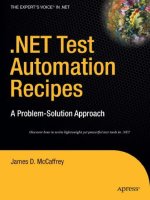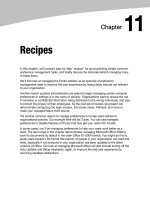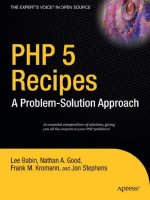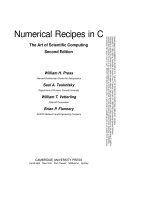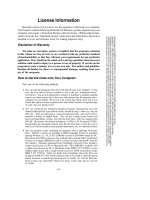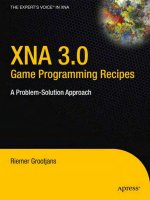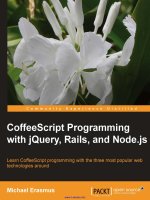Rails Recipes potx
Bạn đang xem bản rút gọn của tài liệu. Xem và tải ngay bản đầy đủ của tài liệu tại đây (1.99 MB, 297 trang )
Rails Recipes
Chad Fowler
The Pragmatic Bookshelf
Raleigh, North Carolina Dallas, Texas
Many of the designations used by manufacturers and sellers to distinguish their products
are claimed as trademarks. Where those designations appear in this book, and The
Pragmatic Programmers, LLC was aware of a trademark claim, the designations have
been printed in initial capital letters or in all capitals. The Pragmatic Starter Kit, The
Pragmatic Programmer, Pra gmatic Programming, Pragmatic Bookshelf and the linking g
device are trademarks of The Pragmatic Programmers, LLC.
Every precaution was taken in the preparation of this book. However, the publisher
assumes no responsibility for errors or omissions, or for damages that may result from
the use of information (including program listings) contained herein.
Our Pragmatic courses, workshops, and other products can help you and your team
create better software and have more fun. For more information, as well as the latest
Pragmatic titles, please visit us at
Copyright
©
2006 The Pragmatic Programmers LLC.
All rights reserved.
No part of this publication may be reproduced, stored in a retrieva l system, or transmit-
ted, in a ny form, or by any means, electronic, mechanical, photocopying, recording, or
otherwise, without the prior consent of the publisher.
Printed in the United States of America.
ISBN 0-9776166-0-6
Printed on acid-free paper with 85% recycled, 30% post-consumer content.
P1.0 printing, June, 2006
Version: 2006-5-15
Contents
Introduction vii
What Makes a Good Recipe Book? . . . . . . . . . . . . . . . . vii
Who’s It For? . . . . . . . . . . . . . . . . . . . . . . . . . . . . viii
Rails Version . . . . . . . . . . . . . . . . . . . . . . . . . . . . . viii
Resources . . . . . . . . . . . . . . . . . . . . . . . . . . . . . . viii
Acknowledgments . . . . . . . . . . . . . . . . . . . . . . . . . . ix
Tags and Thumb tabs . . . . . . . . . . . . . . . . . . . . . . . xi
Part I—User Interface Recipes 1
1. In-Place Form Editing . . . . . . . . . . . . . . . . . . . . 2
2. Making Your Own JavaScript Helper . . . . . . . . . . . 8
3. Showing a Live Preview . . . . . . . . . . . . . . . . . . . 15
4. Autocomplete a Text Field . . . . . . . . . . . . . . . . . . 18
5. Cr eat i ng a Drag-and-Drop Sortable List . . . . . . . . . 20
6. Update Multiple Elements with One Ajax Request . . . . 26
7. Lightning-Fast JavaScript Autocompletion . . . . . . . . 31
8. Cheap & Easy Theme Support . . . . . . . . . . . . . . . 36
9. Trim Static Pages with Ajax . . . . . . . . . . . . . . . . . 37
10. Smart Pluralization . . . . . . . . . . . . . . . . . . . . . 38
11. Debugging Ajax . . . . . . . . . . . . . . . . . . . . . . . . 39
12. Creating a Custom Form Builder . . . . . . . . . . . . . 41
13. Make Pretty Graphs . . . . . . . . . . . . . . . . . . . . . 45
Part II—Database Recipes 49
14. Rails without a Database . . . . . . . . . . . . . . . . . . 50
15. Connecting to Multiple Databases . . . . . . . . . . . . . 55
16. Integrating with Legacy Databases . . . . . . . . . . . . . 63
17. DRY Up Your Database Configuration . . . . . . . . . . . 66
18. Self-referential Many-to-Many Relationships . . . . . . . 68
19. Tagging Your Content . . . . . . . . . . . . . . . . . . . . 71
CONTENTS v
20. Versioning Your Models . . . . . . . . . . . . . . . . . . . 78
21. Converting to Migr ation-Based Schemas . . . . . . . . . 83
22. Many-to-Many Relationships with Extra Data . . . . . . 89
23. Polymorphic Associations—has_many :whatevers . . . . 94
24. Add Behavior to Active Record Associations . . . . . . . 99
25. Dynamically Configure Your Database . . . . . . . . . . 103
26. Use Active Record Outside of Rails . . . . . . . . . . . . 104
27. Perform Calculations on Your Model Data . . . . . . . . 105
28. DRY Up Active Record Code with Scoping . . . . . . . . 107
29. Make Dumb Data Smart with composed_of() . . . . . . . 108
30. Safely Use Models in Migrations . . . . . . . . . . . . . . 112
Part III—Controller Recipes 114
31. Authenticating Your Users . . . . . . . . . . . . . . . . . 115
32. Authorizing Users with Roles . . . . . . . . . . . . . . . . 121
33. Cleaning Up Controllers with Postback Actions . . . . . 126
34. Monitor Expiring Sessions . . . . . . . . . . . . . . . . . 127
35. Rendering Comma-Separated Values from Your Actions 129
36. Make Your URLs Meaningful (and Pretty) . . . . . . . . . 131
37. Stub Out Authentication . . . . . . . . . . . . . . . . . . 136
38. Convert to Active Record Sessions . . . . . . . . . . . . . 137
39. Write Code That Writes Code . . . . . . . . . . . . . . . . 138
40. Manage a Static Site with Rails . . . . . . . . . . . . . . 143
Part IV—Testing Recipes 144
41. Creating Dynamic Test Fixtures . . . . . . . . . . . . . . 145
42. Extracting Test Fixtures from Live Data . . . . . . . . . 150
43. Testing Across Multiple Controllers . . . . . . . . . . . . 155
44. Write Tests for Your Helpers . . . . . . . . . . . . . . . . 161
Part V—Big-Picture Recipes 163
45. Automating Development with Your Own Generators . . 164
46. Continuously Integrate Your Code Base . . . . . . . . . 171
47. Getting Notified of Unhandled Exceptions . . . . . . . . 176
48. Creating Your Own Rake Tasks . . . . . . . . . . . . . . 180
49. Dealing with Time Zones . . . . . . . . . . . . . . . . . . 186
50. Living on the Edge (of Rails Development) . . . . . . . . 192
51. Syndicate Your Site with RSS . . . . . . . . . . . . . . . . 196
52. Making Your Own Rails Plugins . . . . . . . . . . . . . . 204
CONTENTS vi
53. Secret URLs . . . . . . . . . . . . . . . . . . . . . . . . . . 208
54. Quickly Inspect Your Sessions’ Contents . . . . . . . . . 212
55. Sharing Models between Your Applications . . . . . . . . 214
56. Generate Documentation for Your Application . . . . . . 216
57. Processing Uploaded Images . . . . . . . . . . . . . . . . 217
58. Easily Group Lists of Things . . . . . . . . . . . . . . . . 221
59. Keeping Track of Who Did What . . . . . . . . . . . . . . 222
60. Distributing Your Application As One Directory Tree . . 227
61. Adding Support for Localization . . . . . . . . . . . . . . 230
62. The Console Is Your Friend . . . . . . . . . . . . . . . . . 236
63. Automatically Save a Draft of a Form . . . . . . . . . . . 238
64. Validating Non–Active Record Objects . . . . . . . . . . . 241
65. Easy HTML Whitelists . . . . . . . . . . . . . . . . . . . . 244
66. Adding Simple Web Services to Your Actions . . . . . . . 247
Part VI—Email Recipes 252
67. Send Gracefully Degrading Rich-Content Emails . . . . 253
68. Testing Incoming Email . . . . . . . . . . . . . . . . . . . 257
69. Sending Email with Att achments . . . . . . . . . . . . . 265
70. Handling Bounced Email . . . . . . . . . . . . . . . . . . 268
Part VII—Appendix 275
A Resources 276
A.1 Bibliography . . . . . . . . . . . . . . . . . . . . . . . . . 276
A.2 Source Code . . . . . . . . . . . . . . . . . . . . . . . . . . 276
Introduction
What Makes a Good Recipe Book?
If I were t o buy a real recipe book—you know, a book about cooking
food—I wouldn’t be looking for a book that tells me how to dice vegeta-
bles or how to use a skillet. I can find that kind of information in an
overview about cooking.
A recipe book is about how to make food you might not be able to easily
figure out how to make on your own. It’s about skipping the trial and
error and jumping straight to a solution that works. Sometimes it’s
even about making food you never imagined y ou could make.
If you want to learn how to make great Indian food, you buy a recipe
book by a great Indian chef and follow his or her directions. You’re not
just buying any old solution. You’re buying a solution you can trust to
be good. That’s why famous chefs sell lots and lots of books. People
want to make food that tastes good, and these chefs know how to make
(and teach you how to make) food that tastes good.
Good recipe books do teach you techniques. Sometimes they even teach
you about new tools. But they teach these skills within the context and
with the end goal of making something—not just to teach them.
My goal for Rails Recipes is to teach you how to make great stuff with
Rails and to do it right on your first try. These recipes and the tech-
niques herein are extractions from my own work and from the “great
chefs” of Rails: the Rails core developer team, the leading trainers and
authors, and the earliest of ear l y adopters.
I also hope to show you n ot only how to do things but to explain why
they work the way they do. After reading through the recipes, you
should walk away wi th a new level of Rails understanding to go w i th a
huge list of successfully implemented hot new application features.
WHO’S IT FOR? viii
Not all of these recipes are long and involved. To spice things up, I’ve
included a number of smaller offering s, which I’ve called snacks. Typi-
cally one or two pages long, these snacks will help satisfy those cravings
we all get between meals.
Who’s It For?
Rails Recipes is for people who understand Rails and now want to see
how an experienced Rails developer would attack specific problems.
Like with a real recipe book, you should be able to flip through the
table of contents, find something you need to get done, and get from
start to finish in a matter of minutes.
I’m going to assume that you know the basics or that you can find
them in a tutorial or an online r eference. When y ou’re busy trying to
make something, you don’t have spare time to read through introduc-
tory material. So if you’re still in the beginning stages of learning Rails,
be sure to have a copy of Agile Web Development with Rails [
TH05] and
a bookmark to the Rails API documentation handy.
1
Rails Version
The examples in this book, except where noted, should work with Rails
1.0 or higher. Several recipes cover new feat ures that were released
with Rails 1.1.
Resources
The best place to go for Rails infor mation is the Rails website.
2
From
there, you can find the mailing lists, irc channels, and weblogs.
The Pragmatic Programmers have also set up a forum for Rails Recipes
readers to discuss t he recipes, help each other with problems, expand
on the solutions, and even write new recipes. While Rails Recipes was
in beta, th e forum served as such a great resource for ideas that more
than one reader-posted recipe made it into the book! You can find the
forum at
/>1
2
ACKNOWLEDGMENTS ix
The book’s errata list is at http://books.p ragprog.com/titles/fr_rr/errata. If
you submit any problems you find, we’ll list th em there.
You’ll find links to the source code for almost all the book’s examples
at
/>If you’re reading the PDF version of this book, you can report an error
on a page by clicking the “erratum” l i nk at the bottom of the page,
and you can get to the source code of an example by clicking the gray
lozenge containing the code’s file name that appears before the l i sting.
Acknowledgments
Dave Thomas is a mentor and role model to a constantl y growing seg-
ment of our industry—particularly wi thin the Ruby world. I can’t imag-
ine writing a book for another publisher. Anythin g else would undoubt-
edly be a huge step backward. If this book h elps you, it’s due in no
small part to the influence Dave Thomas and Andy Hunt have had on
the book and on me.
David Heinemeier Hansson created Rails, which led me and a legion
of Rubyists to fulltime work pursuing our passion. David has been a
friend and supporter since we met through the R uby community. His
ideas and encouragement made Rails Recipes better.
Thanks to Shaun Fanning and Steve Smith for building a gr eat com-
pany around a great product and having the guts and vision to start
over from scratch in Rails. As a software developer, Naviance is th e
work environment I’ve dreamt of, and the depth and complexity of wh at
we do has been a growth catalyst for me as a software developer in
general and as a Rails developer in particular.
Mike Clark seemed to pop up on my IM client with an inspiring com-
ment or a killer recipe idea as if he could read my mi nd and knew when
I needed it most.
Sean Mountcastle, Frederick Ros, Bruce Williams, Tim Case, Marcel
Molina Jr., Rick Olson, Jamis Buck, Luke Redpath, David Vincelli, Tim
Lucas, Shaun Fanning, Tom Moertel, Jeremy Kemper, Scott Barron,
David Alan Black, Dave Thomas, and Mike Clark all contributed either
full recipes or code and ideas that allowed the recipes to writ e them-
selves. This book is a community effort, and I can’t thank the contrib-
utors enough.
ACKNOWLEDGMENTS x
The Rails core team members served as an i nvaluable sounding board
during th e development of this book. As I was writing the book, I spent
hours t alking through ideas and working th rough problems with the
people who created the very features I was writing about. Thanks to
Scott Barron, Jamis Buck, Thomas Fuchs, David Heinemeier Hansson,
Jeremy Kemper, Michael Koziarski, Tobias Lütke, Marcel Molina Jr.,
Rick Olson, Nicholas Seckar, Sam Stephenson, and Florian Weber for
allowing me to be a (rather loud) fly on the wall and to witness th e
evolution of this great software as it happened.
Rails Recipes was released as a Beta Book early in its development.
We Ruby authors are blessed with what must be the most thoughtful
and helpful audience in the industry. Rails Recipes was shaped for the
better by these early adopters. Thanks for the bug reports, suggestions,
and even full recipes.
Most important, thanks to Kelly for tolerating long days of program-
ming Ruby followed by long nights and weekends of writing about it. I
couldn’t have done this wit hout you.
Chad Fowler
May 2006
XML
Troubleshooting
Testing
Style
Securi t y
Search
Rails 1.1+
Plugins
Rails Internals
Integration
HTML
Extending Rails
Development Process
Database
Configuration
Automation
API Tips
Ajax
TAGS AND THUMB TABS xi
Tags and Thumb tabs
I’ve tried to assign tags to each recipe. If you want to find
recipes that have something to do with Mail, for example,
find the Mail tab at the edge of this page. Then look down
the side of the book: you’ll find a thumb tab that lines up
with the tab on this page for each appropriate recipe.
Part I
User Interface Recipes
1
Recipe 1
In-Place Form Editing
Problem
Your application has one or more pieces of data that are often edited by
your users—usually very quickly. You want to give your users an easy
way to edit application data in place without opening a separate form.
Solution
Rails makes in-place editing easy with the script.aculo.us InPlaceEditor
control and accompanying helpers. Let’s jump right in and give i t a try.
First, we’ll create a model and controller to demonstrate with. Let’s
assume we’re doing a simple address book application. The following i s
the Active Record mig ration we’ll use to define the schema:
Download InPlaceEditing/db/migrate/001_add_contacts_table.rb
class AddContactsTable < ActiveRecord::Migration
def self.up
create_table :contacts
do |t|
t.column :name, :string
t.column :email, :string
t.column :phone, :string
t.column :address_line1, :string
t.column :address_line2, :string
t.column :city, :string
t.column :state, :string
t.column :country, :string
t.column :postal_code, :string
end
end
def self
.down
drop_table :contacts
end
end
Second, we’ll use the default generated model for our Contact class. To
get th i ngs up and running quickly, we can generate the model, con-
troller, and some sample views by just using the Rails scaffolding:
chad> ruby script/generate scaffold Contact
exists app/controllers/
: : :
create app/views/layouts/contacts.rhtml
create public/stylesheets/scaffold.css
1. IN-PLACE FORM EDITING 3
Now we can start script/server, navigate to http://localhost:3000/contacts/,
and add a contact or two. Click one of your f reshly added contacts’
“Show” links. You should see a plain, white page with an undecorated
dump of your chosen contact’s details. This is the page we’re going to
add our in-place editing controls to.
The first step in any Ajax enablement is to make sure you’ve included
the necessary JavaScript files in your views. Somewhere in the <
head
>
of your HTML document, you can call the following:
<%= javascript_include_tag :defaults %>
I usually put that declaration in my application’s default layout (in
app/views/layouts/application.rhtml) so I don’t have to worry about includ-
ing it (and other application-wide style setti ngs, markup, etc.) in each
view I create. If you need Ajax effects in only certain discrete sections
of your application, you might choose to localize the inclusion of these
JavaScript files. In this case, the scaffolding generator has created the
contacts.rhtml layout for us in the directory app/views/layouts. You can
include the JavaScript underneath the stylesheet_link_tag( ) call in this
layout.
Open app/views/contacts/show.rhtml in your editor. By default, it should
look like this:
Download InPlaceEditing/app/views/contacts/show.rhtml.default
<% for column in Contact.content_columns %>
<p>
<b><%= column.human_name %>:</b> <%=h @contact.send(column.name) %>
</p>
<% end %>
<%= link_to
'Edit'
, :action =>
'edit'
, :id => @contact %> |
<%= link_to
'Back'
, :action =>
'list'
%>
The default show( ) view loops through the model’s columns and dis-
plays each one dynamically, with both a label and its value, rendering
something like Figure
1.1, on the following page.
Let’s start with this file and add the in-place editing controls to our
fields. First we’ll remove the “Edit” link, since we’re not going to need it
anymore. Then we wrap the displayed value with a call to the in-place
editor helper. Your show.rhtml should now look like this:
1. IN-PLACE FORM EDITING 4
Figure 1.1: Basic scaffold view
Download InPlaceEditing/app/views/contacts/show.rhtml
<% for column in Contact.content_columns %>
<p>
<b><%= column.human_name %>:</b>
<%= in_place_editor_field :contact, column.name, {}, :rows => 1 %>
</p>
<% end %>
<%= link_to 'Back', :action => 'list' %>
We’re telling the in_place_editor_field( ) helper that we want it to create
an editing control for the instance variable called @contact with the
attribute that we’re currently on in our loop thr ough t he model’s col-
umn names. To make things a little more concrete, if we weren’t in
the dynamic land of scaffolding, we would create an edit control for a
Contact’s name wi th the following snippet:
<%= in_place_editor_field :contact, :name %>
Note that the in_place_editor_field( ) method expects the name of the
instance variable as its first parameter—not the instance itself (so we
use :contact, not @contact).
Refresh the show( ) page, and you should be able to click one of the
contact’s values to cause the edit control to automatically open in the
current view:
1. IN-PLACE FORM EDITING 5
Clicking the ok button now should result in a big, ugly error in a
JavaScript alert. That’s OK. The in-place edit control has created a
form for editing a contact’s data, but that form has no corresponding
action to submit to. Quickly consulting the application’s log file, we see
the following line:
127.0.0.1 . . . "POST /contacts/set_contact_name/1 HTTP/1.1" 404 581
So the application tr i ed to POST to an action called set_contact_name( )
(notice the naming convention) and received a 404 (not found) r esponse
code in return.
Now we could go into our Co ntactsController and define the method
set_contact_name( ), but since we’re doing something so conventional, we
can rely on a Rails convention to do the work for us! Open the controller
app/controllers/contacts_controller.rb, and add the following line right after
the beginning of the class definition (line 2 would be a good place):
in_place_edit_for :contact, :name
Now if you return to your browser, edit the contact’s name, and click
“ok” again, you’ll find that the data is changed, saved, and redisplayed.
The call to in _place_edit_for( ) dynamically defines a set_contact_name( )
action that will update the contact’s name for us. The other attributes
on the page still won’t work, because we haven’t told the controller to
generate the necessary actions. We could copy and paste the line we
just added, changing the attribute names. But since we w ant edit con-
trols for all the attr i butes of our Contact model and the scaffolding has
already shown us how to reflect on a model’s column names, let’s keep
it DRY and replace the existing in_place_edit_for( ) call with the following:
Download InPlaceEditing/app/controllers/contacts_co ntroller.rb
Contact.content_columns.each do |column|
in_place_edit_for :contact, column.name
end
Now all the attributes should save properly through their in-place edit
controls. Since, as we’ve seen, in_place_edit_for simply generates appro-
priately named actions to handle data updates, if we needed to imple-
ment special behavior for a given edit, we could define our own cus-
tom actions to handle the updates. For example, if we needed special
processing for postal code updates, we would define an action called
1. IN-PLACE FORM EDITING 6
raise( ) Is Your Friend
If I hadn’t just told you how to implement your own custom in-
place edit actions, how would you have known w hat to do?
As we saw in the recipe, we can see what action the Ajax
control is attempting to call by looking at our web server log.
But since it’s making a POST, we can’t see the parameters
in the log. How do you know what parameters an auto-
generated form is expecting without reading through piles of
source code?
What I did was to create an action with the name that I saw in
the logs that looked like the following:
def set_contact_name
raise params.inspect
end
When I submitted the form, I saw the Rails error message with a
list of the submitted parameters at the top.
set_contact_postal_code( ). The in-place edit control form will pass two
notable parameters: the contact’s id, aptly named id and the new value
to use for the update with the parameter key, value.
The in-place edit control uses Active Record’s update_attribute( ) method
to do database updates. This method bypasses Active Record model val-
idations. If you need to p erform validations on each update, you’ll need
to write your own actions for handling the in-place edits.
OK, so these edit fields work. But they’re kind of ugly. How would
you, for example, make the text field longer? An especially long email
address or name would not fit in the default text field size. Many Rails
helpers accept additional parameters that will be passed directly to
their rendered HTML elements, allowing you to easily control factors
such as size.
The InPlaceEditor does things a little differently (and some mi ght say
better). It sets a default class name on the generated HTML form, which
you can then use as a CSS selector. So to customize the size of t he
generated text fields, you could use the following CSS:
.inplaceeditor-form input[type="text"] {
width: 260px;
}
1. IN-PLACE FORM EDITING 7
Of course, since we’re using CSS here, we could do anything possible
with CSS.
Discussion
You’ll notice that our example here assumes th at you want to edit all
your data with a text box. In fact, it’s possible to force the InPlaceEditor
to create either a text field or a <
textarea
> field, using the : rows option
to the fourth parameter of the in_place_editor_field( ) method. Any value
greater than 1 will tell InPlaceEditor to generate a <
textarea
>.
What if you want to edit with something other than free-form text con-
trols? InPlaceEditor doesn’t ship with anything for this by default. See
Recipe
2, Making Your Own JavaScript Helper, on the next page, to
learn how to do it y ourself.
Also, you’ll quickly notice that if a field doesn’t already have a value, the
InPlaceEditor will not allow you to click to edit that field. This limitation
can be worked around by populating empty fields with default values,
such as “Click to edit”.
Recipe 2
Making Your Own JavaScript
Helper
Problem
One of the things I love about Rails is that, though I enjoy taking advan-
tage of many of the user interface benefits that JavaScript provides, it
saves me from writing JavaScript code that I really don’t like to write.
Rails is full of magical one-liners that create exciting user interface
effects—all without having t o touch a line of JavaScript.
Sadly, Rails doesn’t solve every user interface problem I might ever
have. And though its JavaScript helper libraries will continue to grow
(either through the core distribution or through user-contributed plu-
gins), no matter how much freely available code is available, if you’re
doing web applications with rich user i nterfaces, you’re going to even-
tually encounter something application-specific for which you’ll have to
write your own JavaScript code.
But most of the time, though not reusable outside your own project
or company, these little JavaScript snippets will be reusable for you in
your own context.
How can you turn these ugly little inline JavaScript snippets into your
own magical one-liners?
Solution
This recipe calls for a little bit of JavaScript and a little bit of Ruby.
We’re going to write a small JavaScript library, and then we’re going to
wrap it in a Ruby helper that we can then call from our views.
If you’ve read Recipe 1, I n-P lace Form Editing, on page 2, you know that
the built-in InPlaceEditor control supplies a mechanism for generating
only text boxes f or content editing. To demonstrate how to make a
JavaScript helper, we’re going to extend the I nPlaceEditor, giving it the
ability to also generate an HTML <
select
> tag, so clicking an element
to edit it could present the user with a list of valid options, as opposed
to just a text box into which they can type whatever they like.
2. MAKING YOUR OWN JAVASCRIPT HELPER 9
We’ll assume we’re using the same contact management application
described in Recipe 1, In-Place Form Editing, on page 2. If you haven’t
already, set the application up, create your migrations, and gener-
ate scaffolding for the Contact model. Also, since we’re going to be
using Ajax, be sure to include the required JavaScript files in your
app/views/layouts/contacts.rhtml layout file. We’ll start with a simplified
view for our show( ) action. Here’s how your app/views/contacts/show.rhtml
file should look:
Download MakingYourOwnJavaScriptHelper/app/views/contacts/show.rhtml.first_version
<p>
<b>Name:</b> <%= in_place_editor_field :contact, :name %> <br />
<b>Country:</b> <%= in_place_editor_field :contact, :country %>
</p>
<br />
<%= link_to
'Back'
, :action =>
'list'
%>
This view gives us in-place editing of t he name( ) and country( ) attributes
of any Con tact in our database. Clicking the country name will open a
text box like the one in the following image:
The call to in_place_editor_field( ) in the view simply generates the follow-
ing JavaScript (you can see it yourself by viewing the HTML source of
the page in your browser):
<b>Country:</b>
<span class=
"in_place_editor_field"
id=
"contact_country_1_in_place_editor"
>
United States of America
</span>
<script type=
"text/javascript"
>
new Ajax.InPlaceEditor('contact_country_1_in_place_editor',
'/contacts/set_contact_country/1')
</script>
All these magic helpers are really not so magical after all. All they
do is generate JavaScript and HTML fragments for us. It’s just text
generation, but the text happens to be JavaScript.
2. MAKING YOUR OWN JAVASCRIPT HELPER 10
As you’ll remember, our goal is to create our own extension of the
InPlaceEditor that will render a <
select
> tag instead of a text box. Since,
as we can see from the HTML source we just looked at, InPlaceEditor
generates only a JavaScript call, we’re going to have to get into the guts
of the InPlaceEditor control to implement this feature.
The InPlaceEditor is defined in the file public/javascripts/controls.js. Brows-
ing its source, we can see that its init i alizer binds the click event to
the function enterEditMode( ). We can follow this function’s definition
through calls to createForm( ) and then createEditField( ). So to summarize
(and spare you the details), clicking the text of an in-place edit control
calls the createForm( ) JavaScript function that relies on the createEdit-
Field( ) to set up the actual editable field. The createEditField( ) function
creates either an <
input
> field of type "text" or a <
textarea
> and adds
it to the form.
This is good news, because createEditField( ) is a nice, clean entry point
for overriding InPlaceEditor’s field creation behavior. We have many ways
to accomplish this in JavaScript. We won’t go into detail on the imple-
mentation. The approach we’ll use is to take advantage of the Prototype
JavaScript library’s inheritance mechanism to subclass InPlaceEditor.
We’ll make our own class called InPlaceSelectEditor, which will simply
override InPlaceEditor’s createEditField( ) method.
Let’s create our new JavaScri pt class in the file in_place_select_editor.js
in the directory public/javascripts. We can include this file in any page
that needs it. Here’s what that file should look like:
Download MakingYourOwnJavaScriptHelper/public/javascripts/in_place_se l ect_editor.js
Line 1
Ajax.InPlaceSelectEditor = Class.create();
-
Object.extend(Object.extend(Ajax.InPlaceSelectEditor.prototype,
-
Ajax.InPlaceEditor.prototype), {
-
createEditField: function() {
5
var text;
-
if(this.options.loadTextURL) {
-
text = this.options.loadingText;
-
} else {
-
text = this.getText();
10
}
-
this.options.textarea = false;
-
var selectField = document.createElement(
"select"
);
-
selectField.name =
"value"
;
-
selectField.innerHTML=this.options.selectOptionsHTML ||
15
"<option>"
+ text +
"</option>"
;
-
$A(selectField.options).each(function(opt, index){
-
if(text == opt.value) {
2. MAKING YOUR OWN JAVASCRIPT HELPER 11
-
selectField.selectedIndex = index;
-
}
20
}
-
);
-
selectField.style.backgroundColor = this.options.highlightcolor;
-
this.editField = selectField;
-
if(this.options.loadTextURL) {
25
this.loadExternalText();
-
}
-
this.form.appendChild(this.editField);
-
}
-
});
Without getting too deep into a discussion of the i nternals of InPlace-
Editor, let’s quickly walk thr ough this JavaScript to understand the key
points. We start off creating our new InPlaceSelectEditor class, extending
InPlaceEditor, and then overriding the createEditField( ) method. The lines
starting at 6 set the text variable to the current value of the field. We
then create a new <
select
> element at line 12 and set its name to "value"
on the next line. The generated InPlaceEditor actions on the server will
be expecting data with the parameter name "value".
At line 14, we get the value of the selectOptionsHTML parameter, which
can be passed into InPlaceSelectEditor’s constructor in the t hird arg u-
ment (which is a JavaScript Hash). We set the innerHTML of our freshly
generated <
select
> tag to either th e options block passed in or a single
option containing the current value of the field.
3
Finally, the loop starting on line 16 goes through each option until it
finds the current value of the field and sets that option to be selected.
Without this block of code, the select field would unintuitively have a
different initial value than the field is actually set to.
Now we have defined our JavaScript, we need to include it in the page
via our layout file, app/views/layouts/contact.rhtml. Include it like this:
Download MakingYourOwnJavaScriptHelper/app/views/layouts/contacts.rh tml
<%= javascript_include_tag
"in_place_select_editor"
%>
Now let’s make a simple demo view to see this new JavaScript class
in action. Create a new view in app/views/contacts/demo.rhtml with the
following code:
3
Although this code works as advertised in the Firefox and Safari browsers, Internet
Explorer is a bit more finicky when it comes to the use of i nnerHTML. To make this work
with Internet Explorer, you’ll need to construct DOM elements programmatically. For the
sake of brevity and simplicity, we’ll leave that to you as an exercise in JavaScript.
2. MAKING YOUR OWN JAVASCRIPT HELPER 12
Download MakingYourOwnJavaScriptHelper/app/views/contacts/demo.rhtml
<span class=
"in_place_editor_field"
id=
"an_element_we_want_to_edit"
>Some Value</span>
<script type=
"text/javascript"
>
new Ajax.InPlaceSelectEditor(
'an_element_we_want_to_edit',
'/an/update/url',
{ selectOptionsHTML: '
<option>Blah</option>' +
'
<option>Some Value</option>' +
'<option>Some Other Value</option>'});
</script>
Its parameters are the same as those passed to the original InPlaceEditor,
except that the third (optional) Hash argument can accept the additional
selectOptionsHTML key.
Now we have the JavaScript side working, how can we remove the need
for JavaScript programming altogether? It’s time to make a helper!
As we saw earlier, the Rails JavaScript h elpers essentially just generate
text that happens to be JavaScript. What do we need to generate for
this helper? Basically, we just need to generate the equivalent code that
we wrote manually in the previous demo example.
We’ll cheat a little by looking at (and copying) the definition of the
method in_place_editor_field( ) from the java_script_macros_helper.rb file i n
Action Pack. We’ll implement our new helpers as a pair of methods, fol-
lowing the pattern of the InPlaceEditor implementation. We’ll put them
in app/helpers/application_helper.rb to make them available to all our
views. We’ll call the first method in_place_select_editor_field( ). Since
we want to be able to pass in an object and a field name, the job of
in_place_select_editor_field( ) is to set up the id and url parameters to pass
to the InPlaceSelectEditor JavaScript class, based on the supplied object
and field name. Here’s the implementation:
Download MakingYourOwnJavaScriptHelper/app/helpe rs/application_helper.rb
def in_place_select_editor_field(object, method, tag_options = {},
in_place_editor_options = {})
tag = ::ActionView::Helpers::InstanceTag.new(object, method,
self)
tag_options = { :tag =>
"span"
,
:id =>
"#{object}_#{method}_#{tag.object.id}_in_place_editor"
,
:
class =>
"in_place_editor_field"
}.merge!(tag_options)
in_place_editor_options[:url] =
in_place_editor_options[:url] ||
url_for({ :action =>
"set_#{object}_#{method}"
, :id => tag.object.id })
tag.to_content_tag(tag_options.delete(:tag), tag_options) +
in_place_select_editor(tag_options[:id], in_place_editor_options)
end
2. MAKING YOUR OWN JAVASCRIPT HELPER 13
Now as you can see, this method delegates to in_place_select_editor( ),
whose job is to generat e the JavaScript text that will be inserted into
the rendered view. Here’s what in_place_select_editor( ) should look like:
Download MakingYourOwnJavaScriptHelper/app/helpe rs/application_helper.rb
def in_place_select_editor(field_id, options = {})
function =
"new Ajax.InPlaceSelectEditor("
function <<
"'#{field_id}', "
function <<
"'#{url_for(options[:url])}'"
function << (
', '
+ options_for_javascript(
{
'selectOptionsHTML'
=>
%(
'#{escape_javascript(options[:select_options].gsub(/\n/, ""))}'
)
}
)
)
if options[:select_options]
function <<
')'
javascript_tag(function)
end
A fortunate side effect of the way the selectOptionsHTML parameter is
implemented is that it’s easy to use with the Rails form options helpers.
Putting all our work together, here’s app/views/contacts/show.rhtml mod-
ified to use our new helper. Notice that we are supplying the country
list via the built-in Rails country_options_for_select( ) helper.
Download MakingYourOwnJavaScriptHelper/app/views/contacts/show.rhtml
<p>
<b>Name:</b>
<%= in_place_editor_field :contact, :name %> <br />
<b>Country:</b>
<%= in_place_select_editor_field(
:contact,
:country,
{},
:select_options => country_options_for_select) %>
</p>
<br />
<%= link_to 'Back', :action => 'list' %>
After clicking the country name, the form now looks like Figure 2.2, on
the following page.
2. MAKING YOUR OWN JAVASCRIPT HELPER 14
Figure 2.2: Our JavaScript Helper in Action
Discussion
Our in_place_select_editor_field( ) and in_place_select_editor( ) helpers con-
tain an ugly amount of duplication. The built-in in_place_editor_field( )
and in_place_editor( ) JavaScript helpers were not made to be extensible.
It wouldn’t be hard to refactor them to be more pluggable, making our
custom helpers smaller and simpler. That would be the right thing to
do, but it wouldn’t serve the purpose of demonstration in a book as
well. So here’s your homework assignment: refactor the in-place editor
helpers to make them extensible, and then plug this helper in. Submit
your work.
